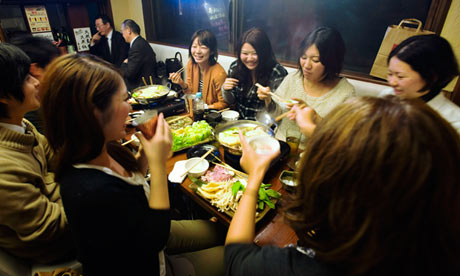
The laughter coming from diners in a corner of Kenji Suzuki's restaurant is flowing as effortlessly as the beer. The chatter cuts through the steam drifting from a nabe, or hotpot, in the centre of the table. There is talk of work, and praise for the chicken, vegetables and tofu being transferred to bowls from the bubbling stock.
Their exuberance is unusual, not just because the working week is only a day old, but because every dish is made with produce many Japanese have spent the past 20 months doing everything possible to avoid.
In an age when serious diners insist on knowing the provenance of their food, the example set by Suzuki's restaurant is hard to beat. About 80% of his menu – from perilla-infused pork to daikon pickles and sake – is from Fukushima.
When it opened on a quiet street in the Takaido neighbourhood of Tokyo in June last year, 47 Dining's prospects were decidedly gloomy.
Suzuki's business plan defied logic: to offer dishes made with ingredients sourced mainly from his hometown of Iwaki, just over 20 miles from the Fukushima Daiichi nuclear power plant, then still in a perilous state after three of its reactors suffered meltdowns in the 11 March triple disaster.
"We were supposed to open in April that year, but then the tsunami and nuclear accident changed everything," Suzuki, 30, said as he prepared for a busy evening.
As soon as he knew his parents had been found safe after being swept along by the tsunami in their car, his thoughts returned to his business, which began in 2009 with a van selling Fukushima produce around Tokyo.
"The day after the disaster, I thought this place was never going to open," he said. "In the weeks after, nothing from Fukushima was going on the market and all our restaurant promotion events were cancelled.
"But then I saw how the tsunami had ruined ports, destroyed seafood and agricultural produce, and I thought 'what can I do to help?'"
What had started as a straightforward business venture became a mission to help the fishermen and farmers of Fukushima prefecture.
"The biggest problem was the nuclear accident," Suzuki said. "Most people seemed to think that everything from Fukushima had been irradiated."
His plans were not helped when, a month after the restaurant opened, tests found that beef cattle from Fukushima containing abnormally high levels of caesium had been processed and eaten.
Confidence in Fukushima produce was shaken again last November, when rice samples from some parts of the prefecture were found to contain caesium levels exceeding government limits. Fukushima, once a byword for some of Japan's finest beef, fruit and seafood, had become indelibly associated with nuclear contamination.
Anonymous callers told Suzuki he was bringing that contamination to Tokyo, while posters on online forums accused him of poisoning his customers. Within weeks of the restaurant opening, bookings had plummeted as nervous diners stayed away.
"People watched the news and decided it was not worth the risk, even though we have never served anything that hasn't been tested and cleared as safe," said Suzuki, who moved to Tokyo 10 years ago.
The restaurant buys produce only from markets where the produce has passed stringent government regulations on radioactive isotopes.
At 47 Dining, the chicken, pork, beef and horse meat is all from Fukushima, as is the rice and most of the vegetables. Lining the counter are bottles of sake made from rice from around the prefecture.
One glaring exception is the seafood. Octopus and whelks were declared safe this summer and, after trial sales at supermarkets in Fukushima, are once again on sale at Tokyo's Tsukiji market.
But fishermen are still banned from operating in large areas of the Pacific off the Fukushima coast, and last month, a study in the journal Science found that radiation levels remained elevated in waters near Fukushima Daiichi, warning that large and bottom-feeding fish could be inedible for a decade.
For now, Suzuki buys fish from Miyagi and Iwate prefectures – where most of the 19,000 people killed by the tsunami had lived – and from Hokkaido in the far north.
Seafood aside, radiation levels in other produce have fallen. Of 105,000 or so food items from the disaster area checked between April and September this year, about 1,360 – half of them from Fukushima – exceeded the caesium limit, according to the health ministry. They included mushrooms, wild game and other produce sourced from forests, rivers and lakes, where radiation tends to be higher, and are all subject to bans.
Armed with those reassurances, public concern over the safety of Fukushima produce slowly diminished, and people started coming to Suzuki's restaurant in droves.
"I eat here regularly because the food is fantastic," said diner Mika Matsumoto. "I'm not worried about radiation because we know that everything has been tested, and tested again. The farmers and fishermen who lost their businesses are doing their best to get back on their feet. If we are helping them by coming here, then that's a plus."
But Suzuki, who recently helped launch a scheme to use restaurants to rejuvenate the economy in Iwaki – home to about 20,000 people evacuated from the nuclear exclusion zone – concedes it will be some time before Fukushima shakes off its association with tainted food.
"I'm sure some people will never eat Fukushima produce," he said. "At the same time there are plenty of others who already are. But people eat here not because of where our dishes come from – they come because they know they're going to get great food."

